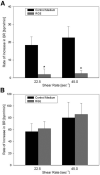Chronotropic response of cultured neonatal rat ventricular myocytes to short-term fluid shear
- PMID: 17012753
- PMCID: PMC3310206
- DOI: 10.1385/CBB:46:2:113
Chronotropic response of cultured neonatal rat ventricular myocytes to short-term fluid shear
Abstract
Ventricular myocytes are continuously exposed to fluid shear in vivo by relative movement of laminar sheets and adjacent cells. Preliminary observations have shown that neonatal myocytes respond to fluid shear by increasing their beating rate, which could have an arrhythmogenic effect under elevated shear conditions. The objective of this study is to investigate the characteristics of the fluid shear response in cultured myocytes and to study selected potential mechanisms. Cultured neonatal rat ventricular myocytes that were spontaneously beating were subjected to low shear rates (5-50/s) in a fluid flow chamber using standard culture medium. The beating rate was measured from digital microscopic recordings. The myocytes reacted to low shear rates by a graded and reversible increase in their spontaneous beating rate of up to 500%. The response to shear was substantially attenuated in the presence of the beta-adrenergic agonist isoproterenol (by 86+/-8%), as well as after incubation with integrin-blocking RGD peptides (by 92+/-8%). The results suggest that the beta-adrenergic signaling pathway and integrin activation, which are known to interact, may play an important role in the response mechanism.
Figures






References
-
- Dou J, Tseng WY, Reese TG, Wedeen VJ. Combined diffusion and strain MRI reveals structure and function of human myocardial laminar sheets in vivo. Magn. Reson. Med. 2003;50:107–113. - PubMed
-
- Dewey CF, Jr., Bussolari SR, Gimbrone MA, Jr., Davies PF. The dynamic response of vascular endothelial cells to fluid shear stress. J. Biomech. Eng. 1981;103:177–185. - PubMed
-
- Sterpetti AV, Cucina A, D'Angelo LS, Cardillo B, Cavallaro A. Response of arterial smooth muscle cells to laminar flow. J. Cardiovasc. Surg. (Torino) 1992;33:619–624. - PubMed
Publication types
MeSH terms
Grants and funding
LinkOut - more resources
Full Text Sources

